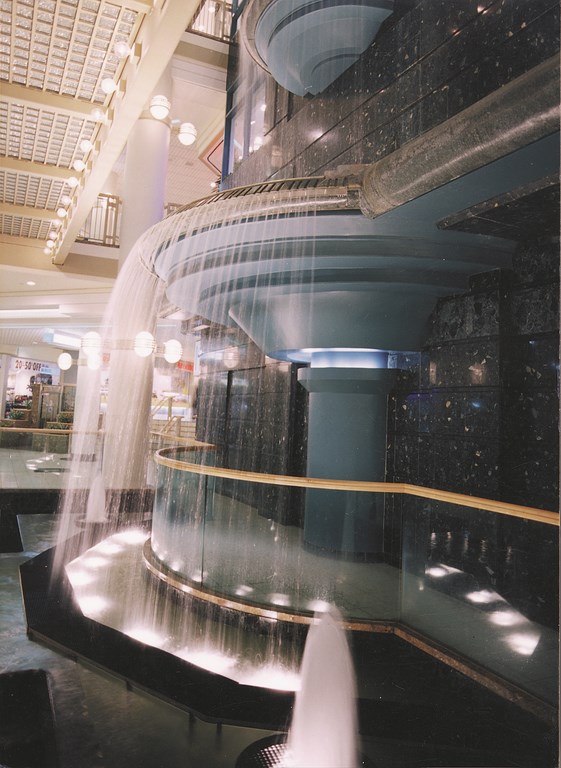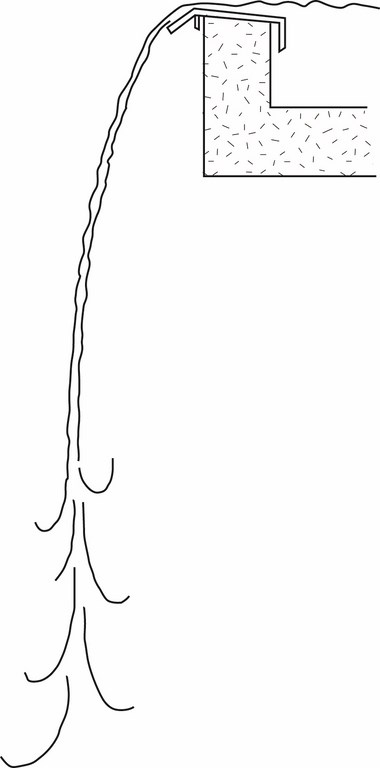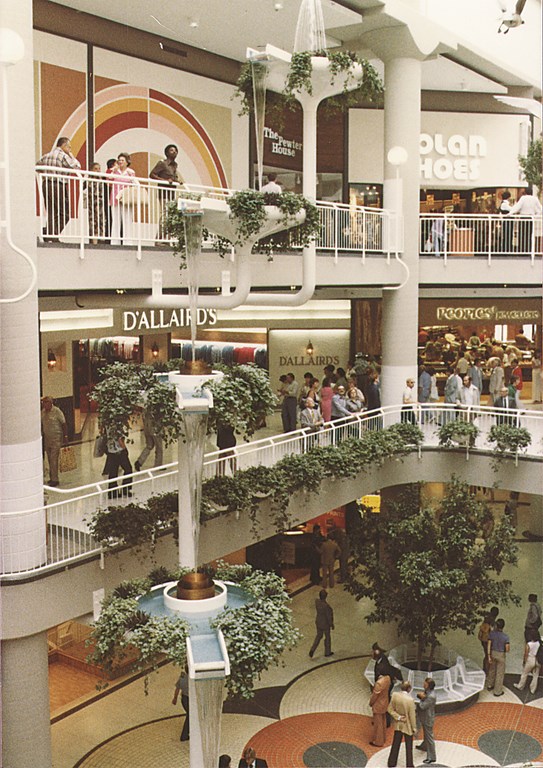Stretching Water

Through all the centuries of watershape design, the laws of physics have imposed restrictions on the watershaper’s ability to extend a laminar flow of sheeting water beyond a drop of five or six feet. Go much beyond that limit and the sheet breaks up, thus impairing the aesthetic effect, causing an annoying degree of splashing and generating an abundance of undesirable, monotonous noise.
Those physical laws have been seriously bent in public spaces in recent times. Indeed, special weirs and nozzles have made it possible to achieve laminar flows of 12 feet or more. Up until now, the solutions employed to achieve these effects have usually been beyond the budget of smaller commercial projects or residential clients – but that’s changing.
At my firm, Crystal Fountains, we’ve long been studying the phenomenon of falling water with an eye toward maximizing the surface tension of water and thereby extending the “laminar” effect without breaking the bank. We’ve had the luxury of working on some high-end projects that enabled us to perform the research and development necessary to do that stretching.
By adapting some of the design ideas we used in those commercial applications, we’ve been able to translate the technology to a scale and price point that makes sense for designers of residential waterfeatures.
FALLING THROUGH HISTORY
Waterfalls and cascades have been used as a decorative water effect since people first began channeling water through aqueducts. They celebrated the places where the water arrived, usually in the center of the village, town or city and understood the role water played as a life-giving resource.
|
Laminar Water By definition, laminar water is water that appears to be clear and turbulence-free as it flows. This can occur in a variety of ways, from the sheets and ribbons described in the accompanying article to laminar arcs that fascinate observers because they appear to be solid rather than liquid when they are actually wet – and moving very quickly. Because laminar flow appears nearly or completely still, it has a mysteriously tactile quality to it. It’s also very calming because the effect is so quiet. In fact, we’ve found that many people don’t believe that laminar water is really water! These are impressions that can best be gained up close, in relatively intimate settings where the minimized noise and splash are most appreciated and where the sheer visual pleasure is most thoroughly enjoyed. – P.L. |
Thousands of years later, contemporary watershapers continue to bring water to the people and still use falling water to create beautiful effects in a huge variety of settings. But water descending more than five or six feet breaks up, producing radical aesthetic changes along with loud noise and unwanted splash.
In commercial settings especially, splash is a major issue with respect to owner liability for wet floors. Combine that with a monotonous roar of an incoherent stream of water breaking the surface of a catch basin and you run into what Doug Duff, our director of design, calls “fountains of doom.”
The reason that water resists stretching beyond the five-to-six-foot limit is that it likes to be a sphere because of its surface tension. Given enough air resistance – simply from the motion of falling – a sheet of water will break up into its natural, globular forms.
The typical falling-water feature will drop from heights of two to ten feet. The spill thickness – that is, the thickness of the laminar sheet as it passes just beyond the weir or nozzle and begins its descent – will range from 0.2 inches at a flow rate of 10 gallons per minute per linear foot to 0.8 inches at 40 gpm per foot.
|
Sound Effects Observers strongly associate sounds with water. When properly designed, however, a laminar fall makes very little noise – a sort of low, “hushing” sound that is unfamiliar to most people. This unusual sound is produced only when the laminar flow strikes the water in the trough (or any hard surface) while it is still coherent. Once it’s broken down into drops, the noise level increases dramatically. – P.L. |
At some point between three and seven feet, the ‘look’ of the falling water will change from a solid unbroken sheet into a random, broken mass of droplets and sheets. This results from the air resistance caused by the increasing velocity of the falling water droplets. You may be able to stretch another foot or two out of the fall by increasing the volume of the flow, but experience has taught us that it’s not worth the extra flow and energy costs.
It’s better instead, we believe, to control a smaller flow than it is to force continuity onto a torrent. After years of trial and error, experimentation, testing and re-testing, we’ve hit upon a number of practical watershaping techniques that can be used to stretch water to maximum lengths.
The fact of the matter is that achieving greater continuity in falling water is not, as many people assume, a matter of pushing more water off a flat weir; rather, it calls for a careful balance of flow, nozzle position and weir configuration.
CUT TO RIBBONS
One solution for achieving laminar fall heights of seven feet or more (without increasing volume) involves designing a different weir shape so the flow is broken up into segments from the beginning of the fall. In other words, this approach calls for “going with the flow” and using water’s tendency to separate to your own advantage.
This technique will produce aesthetic continuity in the form of sheer ribbons from the top of the fall to the bottom (Figure 1, below). Creating these densely packed ribbons of water is a visually interesting way of controlling falling water, even outdoors, from heights of up to 15 feet.
| Figure 1 (left) and Figure 2 (right) |
There are two basic techniques used for creating these ribbons: comb weirs and ejector jets.
A watershape we installed at the John Hancock Center in Chicago offers an example of comb-weir design (Figure 2, above). The installation includes 28 feet of arching comb weir with water falling as far as 10 feet at a flow rate of only 720 gpm.
The comb weir is designed like the tines of a comb or fork attached to a weir plate (Figure 3, below). The openings between the tines produce individual ribbons of water 3/4 inches apart with flow rates of 20 to 25 gpm per linear foot. The individual ribbons of water stay together over a greater distance (up to 15 feet) than water sheets and can flow at half the rate of a typical weir.
| Figure 3 (left) and Figure 4 (right) |
A further benefit of this weir design is greater resistance to wind in outdoor locations. The spaces between the tines of water allow air to pass through the falling water. This creates a sturdier falling-water form – one able to resist lateral wind forces and therefore creating less splashing.
The water wall at Heritage Mall in Edmonton illustrates the stretching effects of ejector jets (Figure 4, above). Here, individual nozzles are grouped into two rows to achieve a powerful effect in a massive falling-water design. The jets are gravity fed and produce impressive effects with small splash footprints.
|
Flat, not Flapping Stretching laminar effects to greater heights and greater drama is a challenge in full-flow operation – but designers also need to consider what happens during start-up and shut-down, when a waving or flapping effect takes over. During these two moments of daily operation, the falling water sheet increases or decreases in thickness. It only lasts five or ten seconds: A thin, temporary sheet of water flaps or waves forward and backward (below at left), creating a splash footprint that can be as large as the length of the falling water itself. The flapping is preventable, however, and the fall length can be stretched to 12 feet by modifying the weir detail and squeezing the water through two weir plates. The squeeze creates thicker edges on the falling sheet of water that help to hold the laminar effect together (above at right). Turbulence in water is the main enemy of laminar effects, sheets and ribbons. To keep water as turbulence-free as possible when it enters the nozzle or trough, you must be sure to limit elbows near the weir or nozzle; limit flow to one foot per second; and use components with turbulence-suppression devices built into the nozzle/weir assembly. – P.L. |
The brass nozzles were press-fitted into a stainless steel trough 1-1/2 inches on center. The second row was offset to produce visual spacing of 3/4 inches – and a massive show of falling water, with 700 gpm falling across 15 feet of trough from 20 feet in height. A 36-inch wide receptor with no splash (and no start-up or shut-down flapping) was achieved.
Plantings could be brought up next to the pools because the threat of burning by water-treatment chemicals was eliminated. And the sound produced is a gentle rip rather than the thunderous roar you might expect of water falling from such height at so high a volume.
STRETCHING OUT
Watershapers are always seeking new ways to face down the physical challenges offered by water. The great thing is that technologies developed for specialized commercial use can often be translated, at reasonable cost, for use in residential settings.
These technologies can (and should) be used to dramatic effect in residential watershapes. They can dress up average installations or make strong, eloquent statements with projects at the high end. Instead of working with water, look at it as playing with water – and using it as a dynamic feature that captivates interest and entertains the child in all of us.
Paul L’Heureux is president of Crystal Fountains, a waterfeature design, engineering and construction firm based in Toronto. Working as a team of experienced architectural waterfeature specialists, the Canadian firm produces high-end commercial fountains and waterfeatures around the world. A “career world traveler,” L’Heureux has more than 20 years’ experience in business management, export marketing and process improvement.
















